

 |
Search the Site with

|
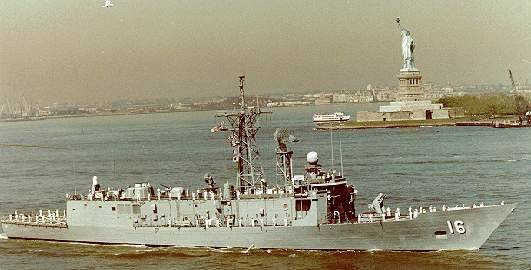 | 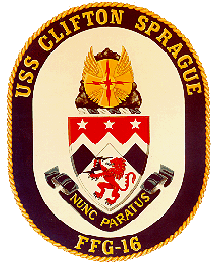 |
USS CLIFTON SPRAGUE was the tenth ship in the PERRY - class of guided missile frigates and the first ship in the Navy to bear the name. Decommissioned on June 2, 1995, the CLIFTON SPRAGUE was subsequently given to the Turkish Navy where she was recommissioned as TCG GAZIANTEP (F 490).
| General Characteristics: | Awarded: February 27, 1976 |
| Keel Laid: July 30, 1979 | |
| Launched: February 16, 1980 | |
| Commissioned: March 21, 1981 | |
| Decommissioned: June 2, 1995 | |
| Builder: Bath Iron Works, Bath, Maine | |
| Propulsion system: two General Electric LM 2500 gas turbines, two 350 Horsepower Electric Drive Auxiliary Propulsion Units | |
| Propellers: one | |
| Blades on each Propeller: five | |
| Length: 445 feet (133.5 meters) | |
| Beam: 45 feet (13.5 meters) | |
| Draft: 24,6 feet (7.5 meters) | |
| Displacement: 4,100 tons | |
| Speed: 28+ knots | |
| Aircraft: one | |
| Armament: one Mk 13 guided missile launcher (36 Standard (MR) and 4 | |
| Crew: 17 Officers, 198 Enlisted |
Crew List:
This section contains the names of sailors who served aboard USS CLIFTON SPRAGUE. It is no official listing but contains the names of sailors who submitted their information.
About the Ship's Coat of Arms: The Shield:
The Shield:
The blue and white zig-zag lines allude to ocean waves which Admiral Sprague sailed over the course of his naval career, and also his nickname "Ziggy." The lion is symbolic of his ability as a commander of naval forces. The blue lightning bolt refers to his command of support aircraft carriers and their significance as a determining factor in World War II Pacific sea battles. The three stars refer to the Admiral's rank, and to "Taffy 3," the task force Admiral Sprague commanded during the Battle of Samar near the Philippines during World War II. They are placed on a red field, indicating the courage he displayed during this battle.
The Crest:
The cloud is a symbol that reflects Admiral Sprague's navigational skill and keen military mind during the Battle of Samar, when he used a smoke screen and a rain squall to avoid the destruction of his own forces, while inflicting severe damage upon the enemy. The wings allude to Admiral Sprague's career as a Naval Aviator, and also refer to his command of support aircraft carriers and various Naval Air Forces during World War II. The lightning flashes refer to the air strike capabilities of those carriers. The cross refers to the Navy Cross awarded to Admiral Sprague for his prowess in directing the counter-offensive at the Battle of Samar.
The Motto:
"NUNC PARATUS" - "Ready Now"
Early History of USS CLIFTON SPRAGUE:
Upon commissioning on 21 March 1981, CLIFTON SPRAGUE became the sixth FFG 7 Class ship to join Destroyer Squadron Eight home ported in Mayport, Florida. During Combat Systems Ship Qualifications Trials from July to August 1981, CLIFTON SPRAGUE conducted a missile-firing exercise, scoring four out of four hits on target drones. This early success was a weather vane of future ship performances.
In June 1982, Commander Destroyer Squadron Eight presented the Battle Efficiency "E" Award to CLIFTON SPRAGUE. At just over a year in service, she became the first FFG 7 Class ship in the Atlantic Fleet to win this award.
On 10 November 1982, CLIFTON SPRAGUE headed south to assume duties as Caribbean Ready Ship, where she was called upon to assist other naval units during hostilities in Grenada.
CLIFTON SPRAGUE headed for her new home port of Philadelphia and service with the Naval Reserve Force, in November 1984. In January 1985, Commander Naval Surface Group Four presented a Meritorious Unit Commendation to CLIFTON SPRAGUE for outstanding performance during hostilities in Grenada.
The ship departed Philadelphia in February for READEX 1-85. During the hostilities phase of the exercise, CLIFTON SPRAGUE scored a perfect three out of three hits on target drones during a missile-firing exercise.
In April 1985, she sailed south to participate in Exercise UNIVERSAL TREK 85, stopping in Key West to embark a Coast Guard Law Enforcement Detachment. Upon completion of the exercise, CLIFTON SPRAGUE proceeded to Mayport to prepare for Operation SOLID SHIELD. During the exercise, she rescued two Belgian Sailors from a life raft. In May 1985, she was awarded the COMNAVSURFLANT Battle Efficiency "E" Award.
In April 1986, CLIFTON SPRAGUE departed Philadelphia to participate in FLEETEX 2-86. The ship performed many duties during FLEETEX, including ASW, torpedo firing, and carrier escort with the USS FORRESTAL (CV 59).
On 4 November 1986, CLIFTON SPRAGUE was once again selected by COMNAVSURFLANT as the Battle Efficiency "E" Award winner for Naval Surface Group Four. This was the second consecutive Battle "E" awarded to the ship, and the third "E" in only five years since commissioning.
After an extensive overhaul period in Philadelphia, and Combat Systems Testing during the Spring and Summer of 1987, CLIFTON SPRAGUE departed Philadelphia in October 1987 for Central American operations, which included port visits in Guantanamo Bay, Cuba, Panama, Jamaica, and Honduras. In December, CLIFTON SPRAGUE received a Blue "E" Efficiency Award in all areas of supply.
1988 was marked by a high operational tempo, starting with Operation SAFE PASS in February. The exercise involved escorting freighters during simulated wartime conditions. In April, CLIFTON SPRAGUE participated in FLEET WEEK in New York City, where over 4,000 visitors toured the ship. CLIFTON SPRAGUE conducted a Chief of Naval Operations Special Operation in Panama City, Florida during May and June, which involved anti-mine warfare testing. The rest of the year was filled with Midshipmen Training, Vandal Missile Exercises, and Operation Propulsion Plant Examination preparations.
About the Ship's Name:
Thus paraphrased is the Navy Cross Citation awarded to Vice Admiral Clifton Albert Frederick Sprague for his "aggressiveness and courage" in 1944 combat near the Philippine Islands.
The high decoration was but one of many awards for valor he earned during an illustrious career, from his entrance into the U.S. Naval Academy, Annapolis, in 1914, until his transfer to the retired list 1 November 1951.
He sailed "in harm's way" from the opening shots at Pearl Harbor, 7 December 1941, when his command, the seaplane tender USS TANGIER, escaped harm while shooting down three raiders, on to epic battles as Commander of the legendary carrier USS WASP.
Assuming command of WASP upon commissioning, 24 November 1943, he guided her to raids on Marcus and Wake Islands, and then assisted in the capture of Saipan, Tinian and Guam.
In August 1944, he took command of Carrier Division 25, later served as Commander of Task Unit 77.4.3, and as Commander of Support Carrier Units. His task unit won the Presidential Unit Citation, and he was awarded two Legions of Merit for "brilliant and courageous leadership."
Born 8 January 1896 in Dorchester, Mass., he attended public schools in Milton, the Roxbury Latin School in Boston, and a year at Norwich University in Vermont before entering the Naval Academy by senatorial appointment from that state.
He served on the cruiser USS WHEELING during World War I, then participated in the crew training and the outfitting of the battleship USS TENNESSEE, remaining with her for one year following her commissioning 3 June 1920.
In 1921, he was designated as a Naval Aviator following flight training at Pensacola, Florida, thus launching an aviation career in scouting and bombing squadrons, national air racing, and including service on such famed carriers as LEXINGTON, SARATOGA, and YORKTOWN. Following World War II, his command positions included Joint Task Group 1.1.2 for atomic bomb tests in the Pacific, Naval Air Basic Training, and then Air Advanced Training at Corpus Christi, Texas, Carrier Division 6, Commander of the 17th Naval District and Commander of the Alaskan Sea Frontier.
He and his wife, the former Annabel Fitzgerald of St. Paul, Minnesota, have two daughters, Mrs. Courtney Vaughn, and Mrs. Patricia Reneau.
Vice Admiral Sprague died 11 April 1955.
USS CLIFTON SPRAGUE Image Gallery:
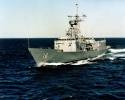 | 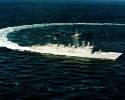 | 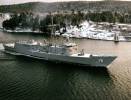 |
After decommissioning the CLIFTON SPRAGUE was recommissioned as TCG GAZIANTEP (F 490) in the Turkish Navy. The photos below were taken by me and show the GAZIANTEP during a port visit to Leith, Scotland, on March 30, 2014, prior to the ship's participation in Exercise Joint Warrior 14-1.
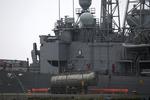 | 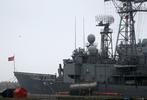 | 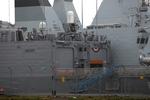 | 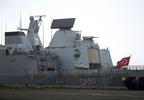 | 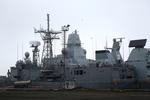 |
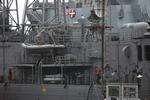 |  | 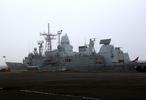 |
 Back to Frigates list.
Back to Frigates list.  Back to ships list.
Back to ships list.  Back to selection page.
Back to selection page.  Back to 1st page.
Back to 1st page.